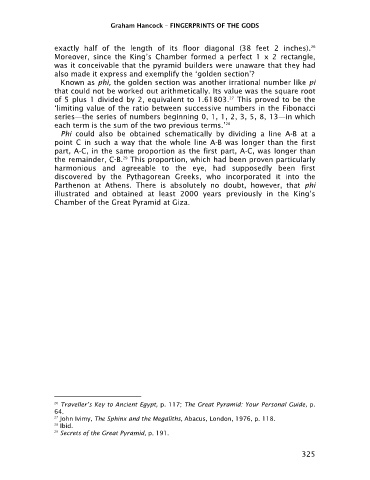Page 327 - Fingerprints of the Gods by Graham Hancock
P. 327
Graham Hancock – FINGERPRINTS OF THE GODS
exactly half of the length of its floor diagonal (38 feet 2 inches).
26
Moreover, since the King’s Chamber formed a perfect 1 x 2 rectangle,
was it conceivable that the pyramid builders were unaware that they had
also made it express and exemplify the ‘golden section’?
Known as phi, the golden section was another irrational number like pi
that could not be worked out arithmetically. Its value was the square root
of 5 plus 1 divided by 2, equivalent to 1.61803. This proved to be the
27
‘limiting value of the ratio between successive numbers in the Fibonacci
series—the series of numbers beginning 0, 1, 1, 2, 3, 5, 8, 13—in which
each term is the sum of the two previous terms.’
28
Phi could also be obtained schematically by dividing a line A-B at a
point C in such a way that the whole line A-B was longer than the first
part, A-C, in the same proportion as the first part, A-C, was longer than
the remainder, C-B. This proportion, which had been proven particularly
29
harmonious and agreeable to the eye, had supposedly been first
discovered by the Pythagorean Greeks, who incorporated it into the
Parthenon at Athens. There is absolutely no doubt, however, that phi
illustrated and obtained at least 2000 years previously in the King’s
Chamber of the Great Pyramid at Giza.
26 Traveller’s Key to Ancient Egypt, p. 117; The Great Pyramid: Your Personal Guide, p.
64.
John Ivimy, The Sphinx and the Megaliths, Abacus, London, 1976, p. 118.
27
28 Ibid.
29 Secrets of the Great Pyramid, p. 191.
325

